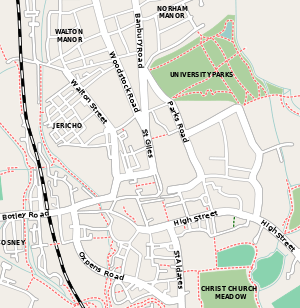Durham College, Oxford
| Colleges and halls of the University of Oxford | |
| Durham College | |
| College name | Durham College |
| Named after | Durham Abbey |
| Established | c. 1291; endowed 1391 |
| Closed | 1545 |
| Priors and Wardens | See below |
| Location | Between St Giles' and Broad Street |

| |
Durham College was the name given to a college of the University of Oxford that existed from the late 13th century to the mid 16th century.
History
The college was built to provide a place of learning for Benedictine monks from the abbey in Durham.[1] The site was acquired by the abbey in 1286[1] or 1291[2] and the site, which would house six to ten monks, developed over the coming decades. A centrally-elected Prior oversaw the development of the College, which included the construction of an oratory in 1323 and groundwork for a chapel shortly thereafter, though no such chapel was actually built.[2] Initially without a permanent income, in 1381, the College received a large endowment from Thomas Hatfield, Bishop of Durham, whose £3000 legacy provided £200 annually for the maintenance of eight student monks (socii or fellows) and eight seculars (scholares or scholars).[1][2] The statutes drawn up stated that the fellows were to take instruction in philosophy and theology; they were also to oversee the selection of the scholars, four of whom were to be drawn from North Yorkshire and four from the Diocese of Durham. Once selected, the eight scholars would learn philosophy and grammar, whilst being paid to assist the monks in unspecified day-to-day tasks. All students were expected to remain for seven or eight years to complete their instruction. The running of the College would be overseen by one of the fellows, who was to take the title of Warden.[2]
The funds proved sufficient for the laying out of a quadrangle around which various buildings were constructed, including living quarters, a refectory, a library (1417–8) and a chapel (1408–9). Several elements of these buildings, mostly from the eastern range, survive as part of Trinity College's Durham Quadrangle.[1] Elements of its pre-Reformation fabric also survive on the opposite side of the quad, at either end of the 17th-century hall. During the English reformation the site was surrendered twice to the crown. The first time, in 1540, it was reported to have an annual income of £115, and was redistributed to the Dean of Durham, who kept it on in much the same form, with a rector, six fellows, and four 'inferior fellows'.[2] Around this time, the buildings on the site were inspected by a surveyor from the Court of Augmentations, providing valuable details about the buildings and the grounds, which were said to consist of three well-proportioned gardens.[1]
Disestablishment
The College was again surrendered to the crown in March 1545, sitting empty thereafter.[1] In 1546, half of the college's grove, having been leased to St. Bernard's College, Oxford, for some time, was granted along with St Bernard's to Christ Church. The garden would eventually becoming part of the original site of St John's College, Oxford, upon its foundation in 1555.[1] On 20 February 1554/5 the remainder of the site, having been redistributed in 1553 to private owners (Dr George Owen of Godstow and William Martyn of Oxford) was sold to self-made politician Thomas Pope, who used them to found Trinity College 16 days later.[1] Durham College was originally dedicated to the Virgin Mary, St Cuthbert, and the Trinity, and it is thought that Trinity College took its name from the last element of this dedication.[3]
Priors (later Wardens)
Drawn from Oxford History Society's Collectanea.[2]
- Gilbert Elwyk, S.T.P., occurs 1316
- John de Beverlaco, S.T.P., occurs 1333
- R—de C—, (fn. 13) between 1340–60
- ? Uthred de Boldon, S.T.P., c. 1360
- ? John Aclyff, or de Acley, c. 1380
- Robert Blaklaw, c. 1389–1404
- William Appylby, 1404-9
- Thomas Rome, S.T.P., 1409–19
- William Ebchester, S.T.P., 1419–28
- Richard Barton, S.T.B., 1428–31
- John Mody, S.T.P., 1431-c. 1440
- John Burnby, S.T.P., 1442–50
- Richard Bell, S.T.B., 1450–53
- John Burnby, again, 1453–56
- Thomas Caly, S.T.B., 1457-c. 1463
- Robert Ebchester, S.T.P., -c. 1464 c. 1475
- William Law, S.T.B., c. 1478-c. 1481
- John Aukland, S.T.P., c. 1481-9
- Thomas Rowland, S.T.B., 1484-7
- Thomas Castell, S.T.P., 1487–94
- William Cawthorne, S.T.P., 1494-c. 1501
- Thomas Swalwell, S.T.P., c. 1501
- ? Thomas Castell, occurs 1511
- Hugh Whitehead, S.T.P., 1512-c. 1519
- Edward Hyndmer alias Henmarsh, S.T.P., c. 1527–41
- George Clyff, S.T.B., 1541-2
References
Bibliography
- Hopkins, Clare (2005), Trinity: 450 years of an Oxford college community (2007 reprint ed.), Oxford, ISBN 978-0-19-951896-8
- Page, William, ed. (1907), "Houses of Benedictine monks: Durham College, Oxford", A History of the County of Oxford, 2, British History Online, pp. 68–70, retrieved 30 August 2012